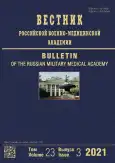Эндогенный гиперкортизолизм: достижения и перспективы в диагностике и лечении
- Authors: Maistrenko N.A.1, Romashchenko P.N.1, Cherebillo V.Y.2, Dovganyuk V.S.1
-
Affiliations:
- Military Medical Academy named after S.M. Kirov
- Pavlov State Medical University of the Ministry of Health of the Russian Federation
- Issue: Vol 23, No 3 (2021)
- Pages: 9-16
- Section: Clinical trials
- URL: https://journals.rcsi.science/1682-7392/article/view/73193
- DOI: https://doi.org/10.17816/brmma73193
- ID: 73193
Cite item
Abstract
The results of examination and treatment of 647 patients with endogenous hypercortisolism were studied: pituitary corticotropinoma was detected in 494 (76.4%) patients, corticosteroma and pre — corticosteroma of the adrenal gland — in 142 (21.9%), bilateral macro-nodular hyperplasia of the adrenal glands of primary adrenal origin-in 11 (1.7%). Differential diagnosis of clinical forms of endogenous hypercortisolism was based on the assessment of the level of adrenocorticotropic hormone and cortisol, both in peripheral blood, and with selective bilateral blood sampling from the adrenal veins and lower stony sinuses, and the study of the nature of samples with 8 mg of dexamethasone. Topical diagnostics consisted in assessing the state of the adrenal glands and pituitary gland during computed tomography and magnetic resonance imaging with the use of contrast agents, and the use of special software 3D-Volume Rendering Technique allowed optimizing tactical and technical approaches to performing surgical interventions. Of the operated patients with adrenocorticotropic hormone dependent endogenous hypercortisolism, total removal according to the control magnetic resonance imaging was achieved in 92.3% of cases, subtotal — in 7.7%. However, hormonal remission was achieved only in 82.4% of cases. All patients with corticosteroma and pre-corticosteroma of the adrenal gland underwent adrenalectomy: in 6 patients by open method, in 136 patients by endovideosurgical method (in 11 patients by laparoscopic method, in 124 patients by retroperitoneoscopic method, and in 1 patient by thoracoscopic transdiaphragmatic adrenalectomy). In all patients, the operation led to recovery. Patients with benign macronodular hyperplasia of the adrenal glands needed conservative treatment with steroidogenesis blockers. Indications for surgical treatment in the volume of unilateral adrenalectomy occurred only in 2 patients.
Full Text
##article.viewOnOriginalSite##About the authors
Nicolay A. Maistrenko
Military Medical Academy named after S.M. Kirov
Email: nik.m.47@mail.ru
ORCID iD: 0000-0002-1405-7660
SPIN-code: 2571-9603
doctor of medical sciences, professor
Russian Federation, Saint PetersburgPavel N. Romashchenko
Military Medical Academy named after S.M. Kirov
Email: romashchenko@rambler.ru
ORCID iD: 0000-0001-8918-1730
SPIN-code: 3850-1792
doctor of medical sciences, professor
Russian Federation, Saint PetersburgVsevolod Yu. Cherebillo
Pavlov State Medical University of the Ministry of Health of the Russian Federation
Email: cherebillo@mail.ru
ORCID iD: 0000-0001-6803-9954
SPIN-code: 2887-6943
doctor of medical sciences, professor
Russian Federation, Saint PetersburgVitaly S. Dovganyuk
Military Medical Academy named after S.M. Kirov
Author for correspondence.
Email: vit.dov65@rambler.ru
ORCID iD: 0000-0002-0038-795X
SPIN-code: 2713-3684
doctor of medical sciences, associate professor
Russian Federation, Saint PetersburgReferences
- Maystrenko NA. Vladimir Nikolayevich Shamov. (1882–1962). Grekov’s Bulletin OF Surgery. 2012;171(6):9−12. (In Russ.).
- Maystrenko NA, Romashchenko PN, Aliyev AK. Nauchnaya shkola professora S.P. Fedorova. Saint Petersburg: Gumanistika; 2020. 263 p. (In Russ.).
- Kalinin AP, Maystrenko NA, Khirurgiya nadpochechnikov. Moscow: Meditsina; 2000. 214 p. (In Russ.).
- Kalinin AP, Maystrenko NA, Vetshev PS. Khirurgicheskaya endokrinologiya: rukovodstvo. Saint Petersburg: Piter; 2004. 941 р. (In Russ.).
- Maystrenko NA, Vavilov AG, Dovganyuk VS. Sovremennyye aspekty khirurgii nadpochechnikov. Khirurgiya. 2000;5:21–26. (In Russ.).
- Steffensen C, Bak AM, Rubeck KZ. Epidemiology of Cushing’s syndrome. Neuroendocrinology. 2010;92(1):1–5. doi: 10.1159/000314297
- Hirsch D, Tsvetov G, Manisterski Y, et al. Incidence of Cushing’s syndrome in patients with significant hypercortisoluria. Eur J Endocrinol. 2017;176(1):41–48. doi: 10.1530/EJE-16-0631
- Valassi E, Franz H, Brue T, et al. ERCUSYN Study Group. Diagnostic tests for Cushing’s syndrome differ from published guidelines: data from ERCUSYN. Eur J Endocrinol. 2017;176(5): 613–624. doi: 10.1530/EJE-16-0967
- Romashchenko PN. Obosnovaniye dostupov pri endovideokhirurgicheskikh vmeshatelstvakh na nadpochechnikakh. (kliniko-anatomicheskoye issledovaniye): [dissertation] Saint Peterburg; 2000. 24 s. (In Russ.). Available from: https://search.rsl.ru/ru/record/01000264722
- Novoobrazovaniya nadpochechnikov. VD. Fedorova editor. Moscow: Medpraktika; 2002. (In Russ.).
- Endovideokhirurgiya nadpochechnikov. N.A. Maystrenko editor. SPb.: ELBI; 2003. (In Russ.).
- Lacroix A, Feelders RA, Stratakis CA, et al. Cushing’s syndrome. Lancet. 2015;386(9996):913−27. doi: 10.1016/S0140-6736(14)61375-1
- Pivonello R, Leo MDe, Cozzolino A, et al. The treatment of Cushing’s disease. Endocr Rev. 2015;36(4):385–486. doi: 10.1210/er.2013-1048
- Chan KC, Lit LC, Law EL, et al. Diminished urinary free cortisol excretion in patients with moderate and severe renal impairment. Clin Chem. 2004;50(4):757−769. doi: 10.1373/clinchem.2003.029934
- Alwani RA, Schmit Jongbloed LW, de Jong FH, et al. Differentiating between Cushing’s disease and pseudo-Cushing’s syndrome: comparison of four tests. Eur J Endocrinol. 2014;170(4):477−86. doi: 10.1530/EJE-13-0702
- Maystrenko NA, Dovganyuk VS, Fomin NF. Gormonalno-neaktivnyye opukholi nadpochechnikov. Saint Petersburg: ELBI-SPb; 2001. (In Russ.).
- Fassnacht M, Arlt W, Bancos I, et al. Management of adrenal incidentalomas: European Society of Endocrinology Clinical Practice Guideline in collaboration with the European Network for the Study of Adrenal Tumors. Eur J Endocrinol. 2016;175(2):1–34. doi: 10.1530/EJE-16-0467
- Gusaaova NV, Savello AV, Tsoy UA, et al. Experience in the use of combined cavernous and inferior petrosal sinus sampling in the differential diagnostic of acth-dependent cushing’s syndrome. Translational Medicine. 2015;(2–3):31–32). (In Russ.).
- Romashchenko PN, Zheleznyak IS, Blyumina SG, et al. Ct-planning access for adrenalectomy. Bulletin of the Russian Military Medical Academy. 2019;1:105−109. (In Russ.).
- Dovganyuk VS. Sovremennyye tekhnologii v diagnostike i khirurgicheskom lechenii novoobrazovaniy nadpochechnikov. [dissertation] Saint Petersburg; 2005. (In Russ.) Available from: https://www.dissercat.com/content/sovremennye-tekhnologii-v-diagnostike-i-khirurgicheskom-lechenii-novoobrazovanii-nadpochechn
- Bolezn Itsenko-Kushinga: klinika, diagnostika, lecheniye: рrakticheskoye rukovodstvo dlya vrachey. Dedova II, Melnichenko GA, editors. Moscow: UP Print; 2012. (In Russ.).
- Maystrenko NA. Problem aspects of diagnostics and surgical treatment of itsenko-cushing syndrome. Grekov’s Bulletin of Surgery. 2010;154(3):49−56. (In Russ.).
Supplementary files








